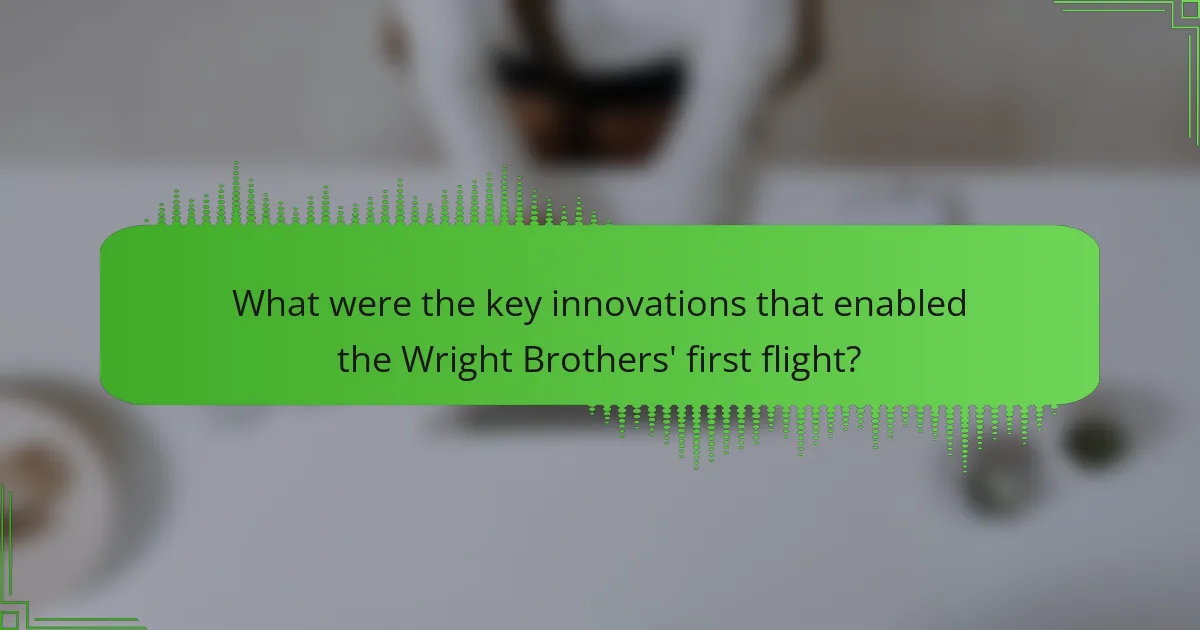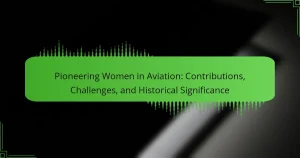The Wright Brothers’ first flight in 1903 revolutionised aviation by demonstrating powered flight’s feasibility. Key innovations included a three-axis control system and a lightweight engine. They faced significant challenges, such as technical failures and public scepticism. Their legacy continues to influence modern aircraft design and the culture of innovation in aviation.

What were the key innovations that enabled the Wright Brothers’ first flight?
The key innovations that enabled the Wright Brothers’ first flight include the three-axis control system, a lightweight engine, and a wind tunnel for testing. The three-axis control system allowed for better manoeuvrability, while the lightweight engine, weighing only 200 pounds, powered their Flyer. The use of a wind tunnel provided critical data to refine wing design and aerodynamics, leading to a successful flight on December 17, 1903.
How did the Wright Brothers develop their aircraft design?
The Wright Brothers developed their aircraft design through systematic experimentation and innovative engineering. They focused on understanding aerodynamics, control mechanisms, and propulsion systems. Their unique attribute was the invention of a movable rudder, allowing better control during flight. They faced challenges, including structural failures and limited funding, but their persistence led to the first powered flight in 1903. This achievement laid the groundwork for modern aviation, influencing future aircraft design and technology.
What role did wind tunnel testing play in their success?
Wind tunnel testing was crucial for the Wright Brothers’ success, enabling them to refine their aircraft designs. This method provided empirical data on aerodynamics, allowing them to understand lift and drag. By systematically testing various wing shapes and configurations, they achieved optimal performance, leading to their historic first flight in 1903. The insights gained from wind tunnel experiments were instrumental in overcoming challenges related to stability and control, setting the foundation for future aviation advancements.
Which materials were crucial in building their aircraft?
The Wright Brothers used wood, fabric, and metal in their aircraft construction. Wood provided structural integrity, while fabric covered the wings for aerodynamics. Metal was utilised for critical components like the engine and control mechanisms.
How did the Wright Brothers’ approach to engine design differ from their contemporaries?
The Wright Brothers’ approach to engine design emphasised lightweight materials and innovative solutions, setting them apart from contemporaries. They focused on creating a compact, efficient engine, using aluminium and a unique four-cylinder design. This contrasted with the heavier, more conventional engines of their time. Their engine weighed only 200 pounds, significantly lighter than others, enabling better flight performance. This emphasis on weight and efficiency was crucial for their success in achieving powered flight.

What challenges did the Wright Brothers face during their quest for flight?
The Wright Brothers faced numerous challenges during their quest for flight, including technical failures, financial constraints, and scepticism from the public. They struggled with achieving controlled flight, requiring extensive experimentation with wing shapes and engine designs. Their initial attempts resulted in crashes and setbacks, demanding perseverance and innovation. Additionally, securing funding for their research was difficult, as many investors doubted the feasibility of human flight. Despite these obstacles, their determination and ingenuity ultimately led to the first successful powered flight in 1903.
How did weather conditions impact their testing and development?
Weather conditions significantly influenced the Wright Brothers’ testing and development of their flying machines. They faced challenges like wind speed and direction, which affected lift and control. For instance, strong winds at Kitty Hawk provided valuable lessons in aerodynamics. The brothers adapted their designs based on real-time weather feedback, enhancing stability. Their understanding of weather ultimately contributed to the success of their first powered flight in 1903.
What financial obstacles did the Wright Brothers encounter?
The Wright Brothers faced significant financial obstacles in their quest for powered flight. They struggled to secure funding for their experiments and inventions, relying heavily on personal savings and loans.
Their early attempts at flight resulted in costly failures, which further strained their finances. Additionally, they sought investors but faced scepticism from potential backers who doubted the feasibility of their work.
Despite these challenges, they remained persistent and resourceful, eventually securing a modest amount of funding from a local bicycle shop owner. This support allowed them to continue their experiments and ultimately achieve their historic first flight in 1903.
How did public skepticism affect their progress?
Public skepticism significantly hindered the Wright Brothers’ progress by limiting funding and support. Many viewed their ideas as impractical, which affected their ability to conduct experiments. This skepticism led to a reliance on personal resources and persistence. Despite the doubts, their innovations ultimately proved successful, changing aviation history.

What was the significance of the Wright Brothers’ first flight in 1903?
The Wright Brothers’ first flight in 1903 marked a pivotal moment in aviation history. This achievement demonstrated the potential of powered flight, overcoming numerous engineering challenges. The flight lasted 12 seconds and covered 120 feet, showcasing the effectiveness of their innovative design. The legacy of this event laid the groundwork for the development of modern aviation, influencing countless innovations in aircraft technology. Their work illustrates the importance of perseverance and creativity in achieving groundbreaking advancements.
How did this achievement change perceptions of aviation?
The Wright Brothers’ first flight shifted perceptions of aviation by proving powered flight was achievable. This achievement inspired innovation and investment in aviation technology. It transformed public interest, leading to advancements in aircraft design and safety. As a result, aviation evolved from a dream to a viable mode of transportation, influencing global connectivity and commerce.
What were the immediate reactions from the public and media?
The immediate reactions from the public and media were overwhelmingly positive and filled with excitement. Many viewed the Wright Brothers’ first flight as a monumental achievement in human innovation. Newspapers across the country reported on the event with enthusiasm, highlighting the technical prowess and determination of the Wright Brothers. Public fascination grew as they recognised the potential of powered flight for transportation and exploration. This event marked a significant turning point in aviation history, inspiring further advancements and capturing the imagination of many.
Which milestones followed their first flight?
The milestones that followed the Wright Brothers’ first flight include the development of improved aircraft designs, the establishment of the Wright Company, and significant advancements in aviation technology. Their first flight in 1903 was just the beginning of a series of innovations that transformed aviation.
In 1904, the Wright Brothers achieved the first controlled, powered flights with their Wright Flyer II, demonstrating longer durations and greater control. By 1905, they introduced the Wright Flyer III, which was the first practical airplane, capable of sustained flight.
In 1909, they showcased their advancements at the Hudson-Fulton Celebration, gaining public recognition. The same year, they established the Wright Company, marking the transition from inventors to aviation entrepreneurs.
These milestones reflect the Wright Brothers’ commitment to overcoming challenges and their lasting legacy in aviation history.

How did the Wright Brothers’ legacy influence modern aviation?
The Wright Brothers’ legacy profoundly shaped modern aviation by introducing key innovations and overcoming significant challenges. Their first powered flight in 1903 demonstrated the feasibility of controlled flight, paving the way for advancements in aerodynamics and aircraft design.
They developed essential technologies, such as the three-axis control system, which remains fundamental in aviation today. Their emphasis on systematic testing and data collection laid the groundwork for future aviation research and development.
As a result, the principles established by the Wright Brothers fostered a culture of innovation in aviation, influencing everything from commercial air travel to military aircraft design. Their legacy is evident in the ongoing pursuit of efficiency, safety, and performance in modern aviation.
What principles of flight established by the Wright Brothers are still relevant today?
The principles of flight established by the Wright Brothers remain relevant today, particularly their focus on control, lift, and propulsion. They introduced the three-axis control system, allowing pilots to manoeuvre effectively. Their understanding of lift through wing design laid the groundwork for modern aerodynamics. Additionally, their innovations in engine technology set the stage for advancements in aircraft propulsion. These foundational concepts continue to influence contemporary aviation practices and aircraft design.
How have their innovations been built upon in contemporary aircraft design?
The innovations of the Wright Brothers have significantly influenced contemporary aircraft design, particularly in aerodynamics and control systems. Their emphasis on wing warping for manoeuvrability laid the groundwork for modern ailerons. Additionally, the development of a lightweight engine has inspired advancements in materials and propulsion technology. The principles of stability and control established by the Wrights are foundational in current flight dynamics. Their legacy continues to drive innovation in efficiency and safety in aviation design.
What honours and recognitions have been awarded to the Wright Brothers?
The Wright Brothers received numerous honours and recognitions for their contributions to aviation. They were inducted into the National Aviation Hall of Fame in 1962. The first successful powered flight in 1903 is celebrated annually as Wright Brothers Day. Additionally, the Wright Flyer was designated a National Historic Landmark in 1963. The brothers received the Collier Trophy in 1911 for their contributions to aeronautics. Their legacy is further honoured with various awards and memorials worldwide, including the Wright Brothers National Memorial in North Carolina.

What lessons can be learned from the Wright Brothers’ journey to flight?
The Wright Brothers’ journey to flight teaches resilience, innovation, and the importance of iterative learning. Their experimentation with gliders led to the first powered flight in 1903, overcoming numerous technical challenges. They emphasised the value of data collection and analysis, refining their designs based on performance feedback. Their legacy inspires future generations in aviation and engineering, highlighting the significance of perseverance in achieving groundbreaking advancements.
What strategies did they use to overcome failure?
The Wright Brothers used perseverance, innovative designs, and systematic experimentation to overcome failure. They faced numerous setbacks, including crashes and engine issues, yet they learned from each attempt. Their methodical approach involved refining their glider designs and testing various wing shapes. By focusing on controlled flight and understanding aerodynamics, they achieved their first successful flight in 1903. Their resilience and commitment to improvement became crucial elements of their legacy in aviation.
How important was collaboration in their success?
Collaboration was crucial to the Wright Brothers’ success in achieving the first flight. Their partnership allowed them to combine skills, share ideas, and overcome challenges. Wilbur’s analytical approach complemented Orville’s hands-on experience, fostering innovation. Together, they meticulously tested and refined their designs, leading to significant advancements in aeronautics. Their teamwork exemplified how collaboration can drive groundbreaking achievements.
What common mistakes should aspiring innovators avoid based on their experience?
Aspiring innovators should avoid underestimating challenges, neglecting research, and resisting collaboration. The Wright Brothers faced numerous obstacles, including limited technology and funding. They learned that thorough experimentation and teamwork were crucial for success. Embracing failure as a learning opportunity can foster resilience and lead to breakthroughs.


